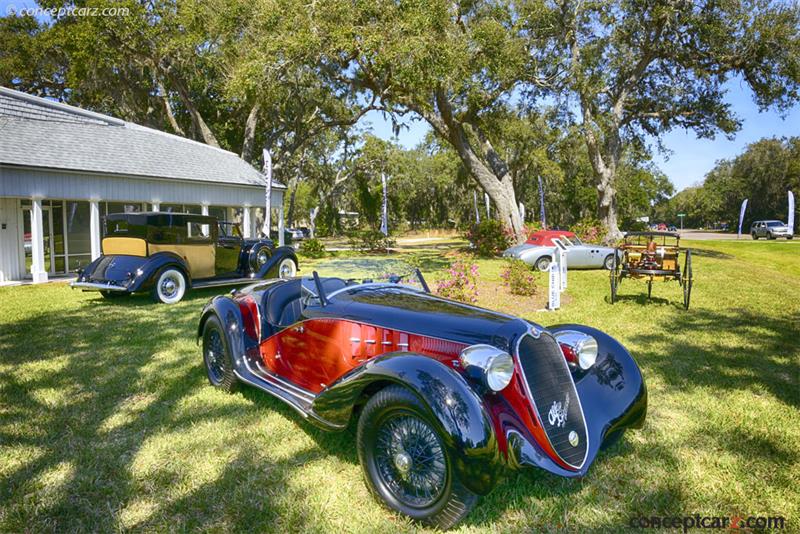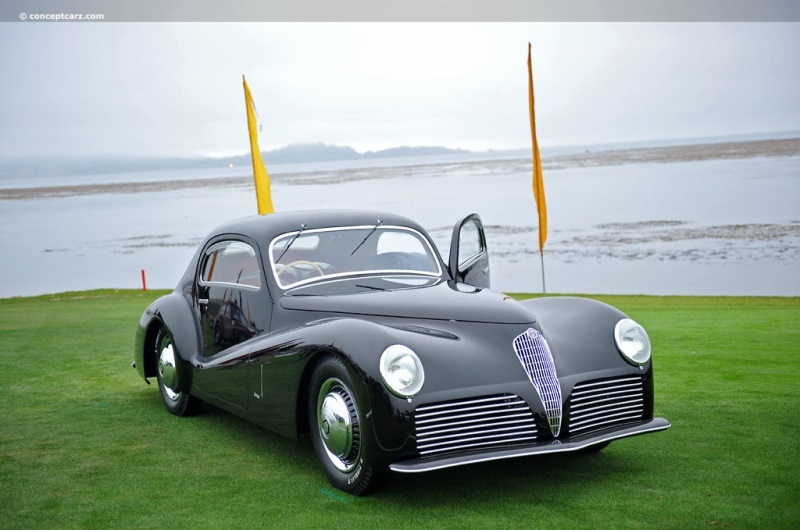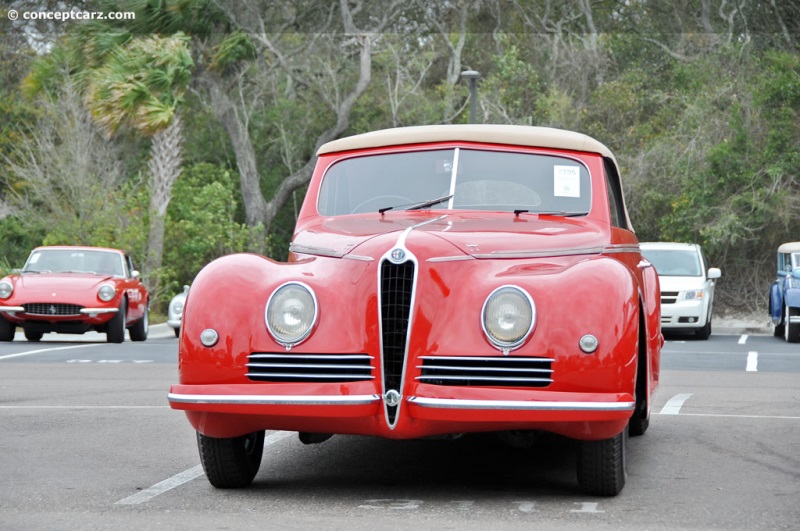The long-lived Alfa Romeo 6C name began in the 1920s and continued through 1954, referencing the company's straight-six engine built in various configurations, and designed for several purposes, including road, race, and sports cars. The genesis of the 6C was the 1500 version, which set the standard for lightweight, high-performance road cars and was followed in 1929 by the 6C 1750. The next evolution of the 6C came in 1934 and nearly doubled the displacement of the car it succeeded. Known as the 6C 2300, it continued the tradition of being a highly competent automobile capable of providing excellent performance with multi-passenger coachwork.
Convertible by Touring
Chassis #: 915128
Engine #: 923928
View info and history
Auction entries : 3The Alfa Romeo 6C 2500 that replaced the 6C 2300 in 1939 employed the basic engine design as its forebearers, and again, the name change signaled a new displacement size. The larger displacement was affected by an increase in the cylinder bore of two millimeters, and additional improvements were made to the cylinder head for better aspiration, and compression increased from 6.5:1 to 7.1:1. In Sport guise, the engine produced a respectable 95 horsepower with performance enhanced by the Superleggera chassis construction developed by Felice Bianchi Anderloni of Carrozzeria Touring.6C 2500 Engine Specification
The Vittorio Jano-designed inline straight-six engine powering the 6C 2500 displaced 2,443cc with a 70 mm (2.8 inch) bore and a 72 mm (2.8 inch) stroke. It has a cast iron block, aluminum cylinder head and twin overhead cams. Built in varying specifications, including with one or three Weber carburetors, the DOHC unit produced between 87 and 145 horsepower. The most potent version was installed in the Competizione and, with the triple carburetor setup, improved cylinder head, and increased compression, produced 145 bhp at 5,500 RPM. The transmission was a four-speed manual unit. 6C 2500 Mechanical Speficaition
The steel ladder frame chassis was offered with three wheelbase sizes, including a 106.3-inch platform for the Super Sport, a 118.1-inch wheelbase for the Sport, and a 128-inch unit for the Turismo. The suspension was independent and braking was handled by four-wheel hydraulic drums.
Convertible by Touring
Chassis #: 915128
Engine #: 923928
View info and history
Auction entries : 3Bodywork was created by a variety of coachbuilders but the majority were crafted by Touring Superleggera of Milan.6C 2500 Production and Body Styles
The Alfa Romeo 6C 2500 was produced from 1938 to 1952 (temporarily postponed during World War II) and was replaced by the 1900. It was one of the most expensive automobiles of its era and was the final 6C built. Approximately 152 examples were the 6C 2500 Coloniale, thirteen of the 6C 2500 Sport, 413 6C 2500 Super Sport Coupes, 8 6C 2500 Super Sport Spyder Corsa, 8 6C 2500 Sport Pinin Farina, 3 6C 2500 Competizione, 36 6C 2500 Villa d'Este, and 680 6C 2500 Freccia d'Oro. Total production was approximately 2,594 units of all chassis variants built between 1939 and 1953. (Note, the production records for this period are incomplete, and production figures continue to vary, with some estimating as few as 2,200 units were built). The 6C 2500 Freccia d'Oro (Golden Arrow) Berlina, with seating for 5/6 passengers, was based on the 2500 Sport and was the first postwar Alfa Romeo. It was powered by a 90 horsepower engine, used a four-speed manual gearbox, and rested on a 120-inch wheelbase.
SS Coupe by Bertone
View info and historyThe 6C 2500 Villa d'Este used the 6C 2500 Super Sport chassis and wore Touring Superleggera coachwork, most with Berlinetta body styles. Introduced in 1949, it was named Villa d'Este after the design won the Concorso d'Eleganza. Production ended in 1952 with after 36 examples were built, including five cabriolets. The 2,443cc engine produced 110 horsepower. The Tipo 256 (6C 2500 Super Sport)
The Tipo 256 was built in 1939 and 1940 to race at the 24 Hours of Le Mans and the Mille Miglia. These racing versions of the 2500 were built in Super Sport Spyder Corsa and Berlinetta Touring body styles and powered by a 125 horsepower version of the 6C engine. Approximately twenty Tipo 256s were produced with chassis numbers in the following ranges: 915006 to 915015 and 915020 to 915029. Most examples were campaigned by Alfa Corse, although a number were reserved for privateers, including Count Franco Mazzotti, Sigfrido Koelliker, and Benito Mussolini. The Tipo 256 is historically significant as it represents the final collaboration between Scuderia Ferrari and Alfa Romeo.Carrozzeria Touring
When Anderloni and partner Gaetano Ponzoni purchased Carrozzeria Falco in 1926, the name was changed to Carrozzeria Touring Superleggera S.r.l. Based in Milan, Italy, it was in close proximity to Alfa Romeo and several other Italian marques, including Isotta-Fraschini and Citroen. As a leader in design and aerodynamic research, including having its own wind tunnel for testing, Touring was able to create efficient designs that, in turn, complemented the high-performance nature of the Alfa Romeo engines. The lightweight Superleggera construction technique used small diameter tubes to form the body's shape, with the framework strengthened and covered by thin alloy panels. The first Touring-built car with the Superleggera system was the Alfa Romeo 6C 2300B, which contested the 1937 Mille Miglia.
SS Coupe by Bertone
View info and historyIn form and function, the Touring-built Alfa Romeos were elegant in conception and execution and finely crafted works of art.Carrozzeria Ghia
Carrozzeria Ghia & Gariglio was established in 1916 by Giacinto Ghia and Gariglio in Italy as an automobile design and coachbuilding firm. Their services were in high demand thanks to its successful application of lightweight aluminum coachwork. During World War II, the company's factory was destroyed during an air raid in 1943, and a year later, Ghia passed away. After the war, Mario Boano and Giorgio Alberti purchased the firm, and the Ghia-Aigle subsidiary was established in Aigle, Switzerland, in 1948.Sig. Boano was a veteran of the Italian coachbuilding industry, having worked for both Pinin Farina and Stabilimenti Farina prior to World War II. Boano would leave the company in 1953, and ownership passed to Segre in 1954 and continued through 1957, when Giovanni Savonuzzi became Direttore Tecnico Progettazione e Produzione Carrozzerie e Stile and continued to improve upon the legacy of Carrzoeria Ghia.
SS Coupe by Bertone
View info and historyAmong the company's memorable designs were the so-called 'Gioiello' and 'Supergioiello' sporty cabriolets built on the Fiat 1100 and Fiat 1400. 'Supergioiello,' meaning 'Super Jewel,' is believed to be the work of Italian designer Giovanni Michelotti.At least four coupe Supergioiello bodies were built atop the Alfa Romeo 6C 2500. They featured steeply raked windscreens, compact greenhouses, graceful profiles, and wheel discs. The first example was purchased by Prince Igor Troubetzkoy for his wife, Barbara Hutton, and the second example made its debut in May 1950 at the Torino Auto Show. The third example was unveiled in August of 1950 at the Concorso d'Eleganza del Lido di Venezia where it wore an attractive two-tone color scheme. The fourth and final example also had a two-tone color scheme, plush subtle tail fins, flush door handles, and redesigned frontal treatment.Carrozzeria Pinin Farina
Of the 425 Super Sport chassis built between 1942 and 1953, approximately 171 were clothed by Pinin Farina, including 63 as cabriolets. The Pinin Farina cabriolet built on the SS short chassis was a two-seater roadster with post-war modern styling. The coachwork was made of steel, with aluminum sometimes used for the hood, doors, and trunk lid. At least four were built entirely in aluminum.Carrozzeria Bertone
Bertone bodied at least one Coupe with a design penned by Mario Revelli di Beaumont.
by Daniel Vaughan | Sep 2023
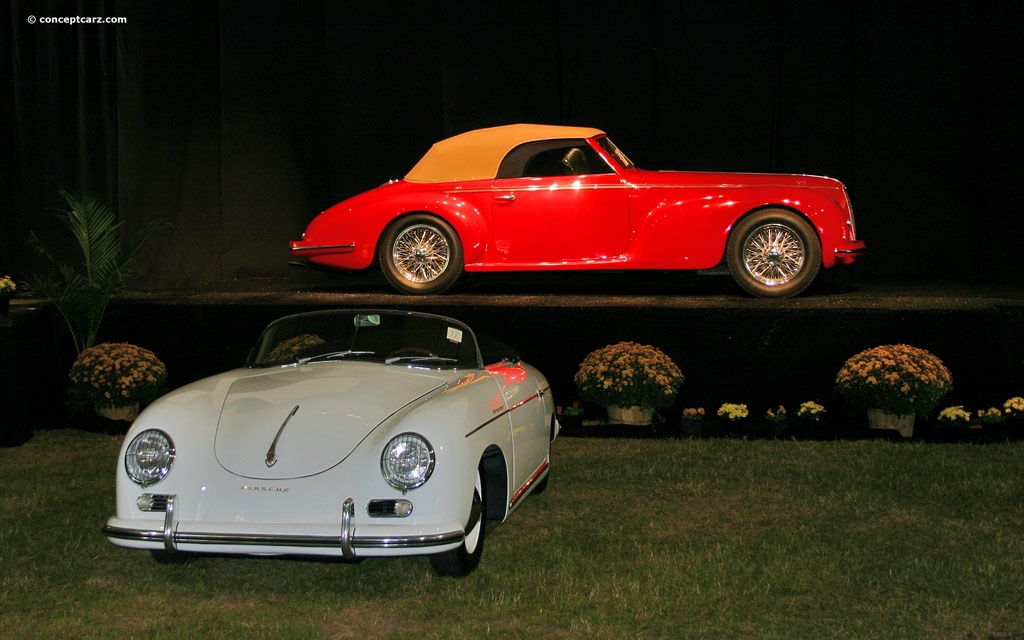
Convertible by Touring
Chassis #: 915128
Engine #: 923928
View info and history
Auction entries : 3
The Vittorio Jano-designed inline straight-six engine powering the 6C 2500 displaced 2,443cc with a 70 mm (2.8 inch) bore and a 72 mm (2.8 inch) stroke. It has a cast iron block, aluminum cylinder head and twin overhead cams. Built in varying specifications, including with one or three Weber carburetors, the DOHC unit produced between 87 and 145 horsepower. The most potent version was installed in the Competizione and, with the triple carburetor setup, improved cylinder head, and increased compression, produced 145 bhp at 5,500 RPM. The transmission was a four-speed manual unit. 6C 2500 Mechanical Speficaition
The steel ladder frame chassis was offered with three wheelbase sizes, including a 106.3-inch platform for the Super Sport, a 118.1-inch wheelbase for the Sport, and a 128-inch unit for the Turismo. The suspension was independent and braking was handled by four-wheel hydraulic drums.
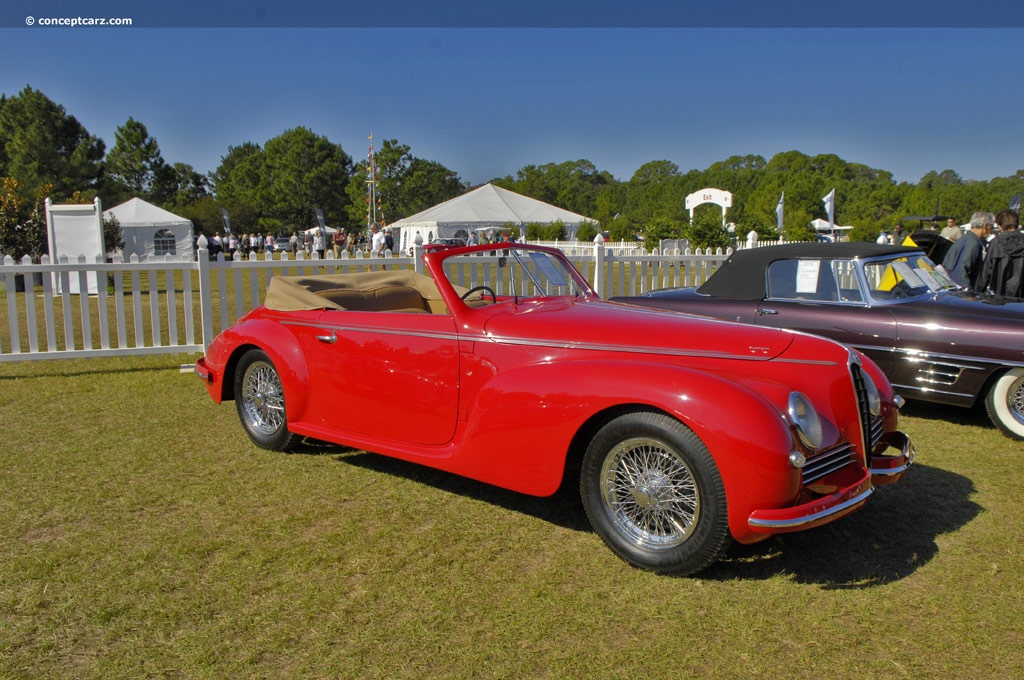
Convertible by Touring
Chassis #: 915128
Engine #: 923928
View info and history
Auction entries : 3
The Alfa Romeo 6C 2500 was produced from 1938 to 1952 (temporarily postponed during World War II) and was replaced by the 1900. It was one of the most expensive automobiles of its era and was the final 6C built. Approximately 152 examples were the 6C 2500 Coloniale, thirteen of the 6C 2500 Sport, 413 6C 2500 Super Sport Coupes, 8 6C 2500 Super Sport Spyder Corsa, 8 6C 2500 Sport Pinin Farina, 3 6C 2500 Competizione, 36 6C 2500 Villa d'Este, and 680 6C 2500 Freccia d'Oro. Total production was approximately 2,594 units of all chassis variants built between 1939 and 1953. (Note, the production records for this period are incomplete, and production figures continue to vary, with some estimating as few as 2,200 units were built). The 6C 2500 Freccia d'Oro (Golden Arrow) Berlina, with seating for 5/6 passengers, was based on the 2500 Sport and was the first postwar Alfa Romeo. It was powered by a 90 horsepower engine, used a four-speed manual gearbox, and rested on a 120-inch wheelbase.
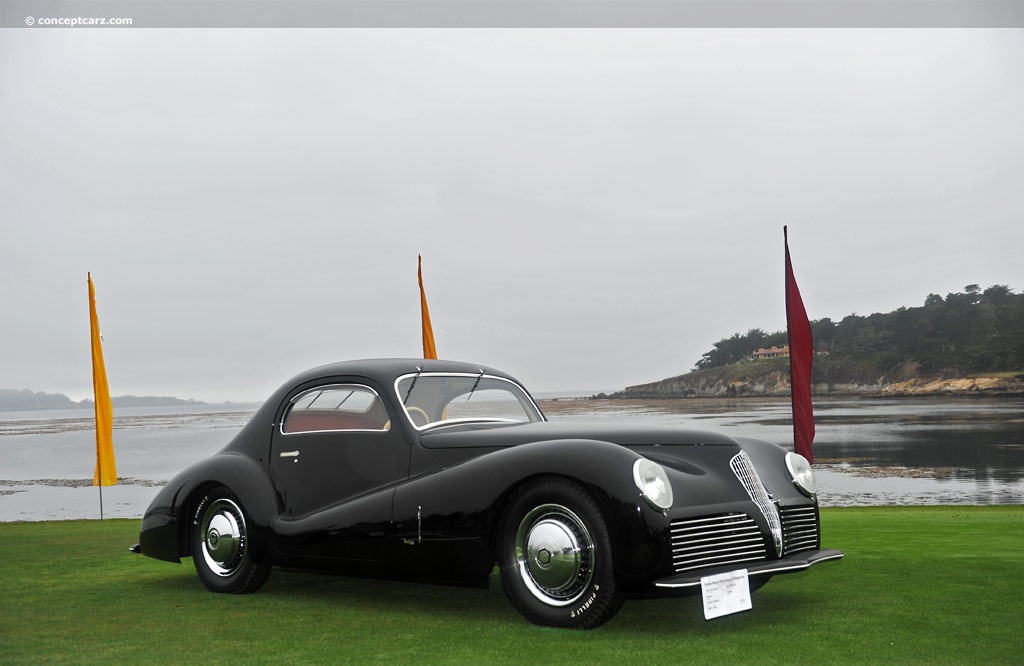
SS Coupe by Bertone
View info and history
The Tipo 256 was built in 1939 and 1940 to race at the 24 Hours of Le Mans and the Mille Miglia. These racing versions of the 2500 were built in Super Sport Spyder Corsa and Berlinetta Touring body styles and powered by a 125 horsepower version of the 6C engine. Approximately twenty Tipo 256s were produced with chassis numbers in the following ranges: 915006 to 915015 and 915020 to 915029. Most examples were campaigned by Alfa Corse, although a number were reserved for privateers, including Count Franco Mazzotti, Sigfrido Koelliker, and Benito Mussolini. The Tipo 256 is historically significant as it represents the final collaboration between Scuderia Ferrari and Alfa Romeo.Carrozzeria Touring
When Anderloni and partner Gaetano Ponzoni purchased Carrozzeria Falco in 1926, the name was changed to Carrozzeria Touring Superleggera S.r.l. Based in Milan, Italy, it was in close proximity to Alfa Romeo and several other Italian marques, including Isotta-Fraschini and Citroen. As a leader in design and aerodynamic research, including having its own wind tunnel for testing, Touring was able to create efficient designs that, in turn, complemented the high-performance nature of the Alfa Romeo engines. The lightweight Superleggera construction technique used small diameter tubes to form the body's shape, with the framework strengthened and covered by thin alloy panels. The first Touring-built car with the Superleggera system was the Alfa Romeo 6C 2300B, which contested the 1937 Mille Miglia.
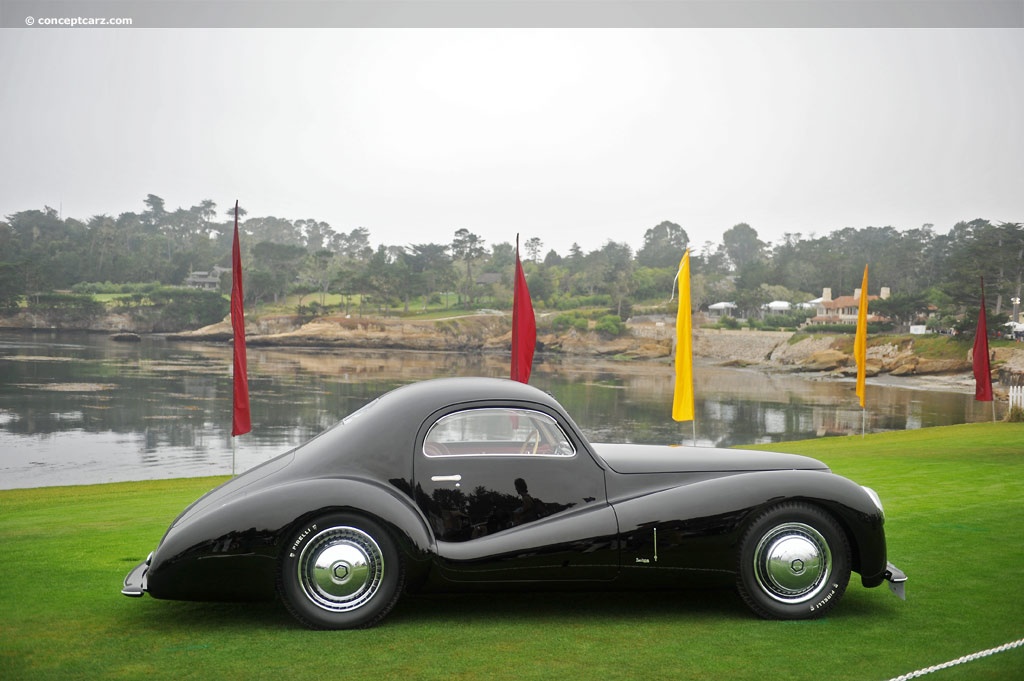
SS Coupe by Bertone
View info and history
Carrozzeria Ghia & Gariglio was established in 1916 by Giacinto Ghia and Gariglio in Italy as an automobile design and coachbuilding firm. Their services were in high demand thanks to its successful application of lightweight aluminum coachwork. During World War II, the company's factory was destroyed during an air raid in 1943, and a year later, Ghia passed away. After the war, Mario Boano and Giorgio Alberti purchased the firm, and the Ghia-Aigle subsidiary was established in Aigle, Switzerland, in 1948.Sig. Boano was a veteran of the Italian coachbuilding industry, having worked for both Pinin Farina and Stabilimenti Farina prior to World War II. Boano would leave the company in 1953, and ownership passed to Segre in 1954 and continued through 1957, when Giovanni Savonuzzi became Direttore Tecnico Progettazione e Produzione Carrozzerie e Stile and continued to improve upon the legacy of Carrzoeria Ghia.
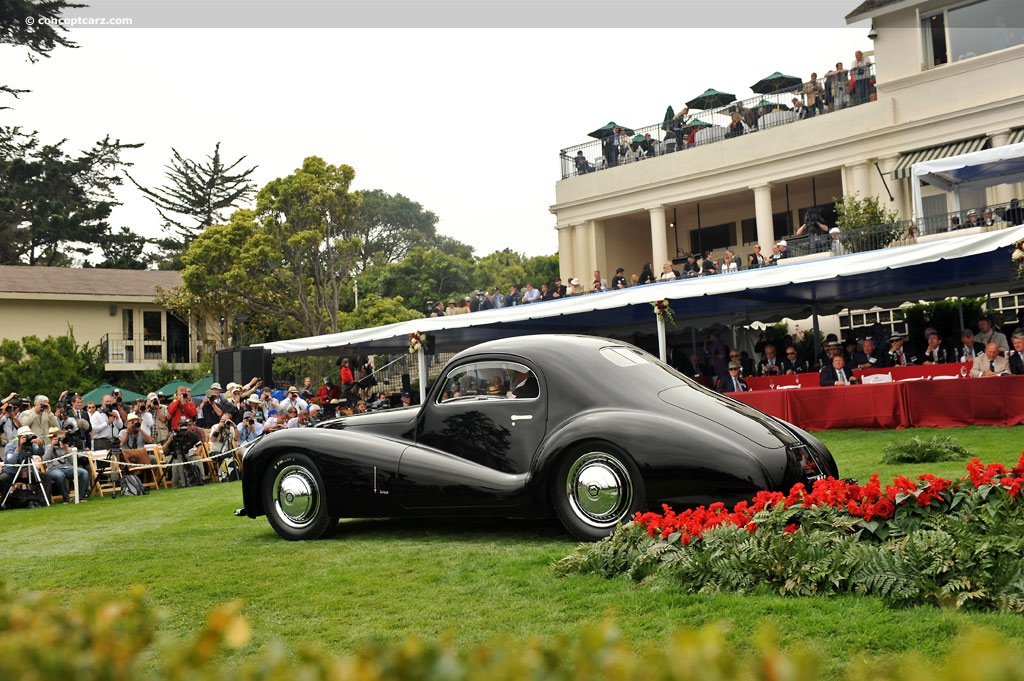
SS Coupe by Bertone
View info and history
Of the 425 Super Sport chassis built between 1942 and 1953, approximately 171 were clothed by Pinin Farina, including 63 as cabriolets. The Pinin Farina cabriolet built on the SS short chassis was a two-seater roadster with post-war modern styling. The coachwork was made of steel, with aluminum sometimes used for the hood, doors, and trunk lid. At least four were built entirely in aluminum.Carrozzeria Bertone
Bertone bodied at least one Coupe with a design penned by Mario Revelli di Beaumont.
by Daniel Vaughan | Sep 2023
Related Reading : Alfa Romeo 6C History
The Alfa Romeo 6C 2500 was introduced near the end of the 1930s. The 6C name was derived from the engine size, an inline-six while the 2500 represented the engines cubic-centimeter displacement size. The engine was a version of Vittorio Jano designed a six-cylinder engine. The 6C was available in a plethora of body styles and wheelbases and was produced during two different times in history.....
Continue Reading >>
Continue Reading >>
Related Reading : Alfa Romeo 6C 2500 History
The engine in the 1927 Alfa Romeo 6C 1500 was the basis for a series of engines that would eventually define the marque as one of the great manufacturers of the pre-war era. The Vittorio Jano-designed engine was expanded to 1752cc and became the 6C 1750, which, in various body styles and tunes, would become the backbone of Alfa Romeo production from 1929 to 1933. Two additional cylinders were later....
Continue Reading >>
Continue Reading >>
Alfa Romeo Monthly Sales Volume
March 2023
2,390
1942 Alfa Romeo 6C 2500 Vehicle Profiles
Recent Vehicle Additions
Performance and Specification Comparison
6C 2500 Specification Comparison by Year
Year
Production
Wheelbase
Engine
Prices
Related Automotive News

1932 Duesenberg J Figoni Sports Torpedo Named Best of Show at the 71st Pebble Beach Concours d'Elegance
2022 Charitable Donations Surpass %242.67 Million
A unique Duesenberg reprised its early role as Concours winner by taking the top prize at the Pebble Beach Concours dElegance.
This year, 40 classic cars from 18 countries and 33 states pulled...

Phenomenal Ferraris and Italian Thoroughbreds Offered at Gooding & Company's Pebble Beach Auctions
The auction house announced a stable of Italian star cars, including a 1950 Ferrari 166 MM Berlinetta Le Mans, a 1961 Ferrari 400 Superamerica Series I Coupe Aerodinamico, and a 1954 Ferrari 500 Mondial Series I Spider.
A stunning group of star...

RM Sotheby's To Offer The Petitjean Collection 'Part Ii' – A Ferrari Only Collection From 1959 To 1989 To Be Offered Without Reserve
AN EXCEPTIONAL COLLECTION OF 28 FERRARI ROAD CARS CELEBRATING THREE DECADES OF THE MARANELLO MARQUE HEADS TO PARIS SALE
RM Sothebys announces The Petitjean Collection Part II
Incredible collection of 28 Ferrari road cars to be offer...
The Finest Custom-Bodied Italian Sports Cars Will Be Sold at Gooding & Company's 15th Annual Pebble Beach Auctions
Gooding %26 Company will showcase a selection ofSanta Monica, Calif. (July 18, 2018) – Gooding %26 Company, the official auction house of the Pebble Beach Concours dElegance®, is proud to present a stunning lineup of rare and exceptional Italian coachbuilt...

1938 Alfa Romeo 8C 2900B Touring Spyder Epitomizes The Elegance at Hershey
HERSHEY, PA - The theme for this years Elegance at Hershey is Celebration of Speed. After deciding upon the overall theme, One of the first decisions we made was to choose an automobile that epitomized that concept, stated Steve Moskowitz,...





























